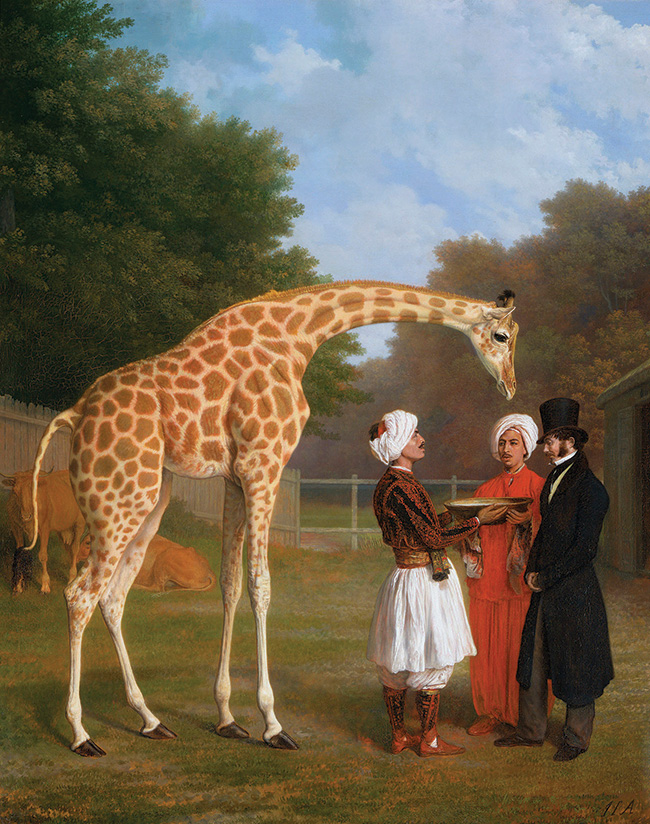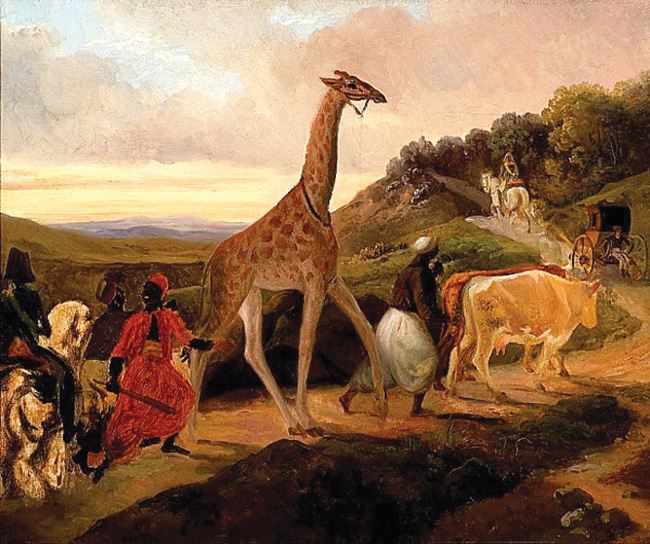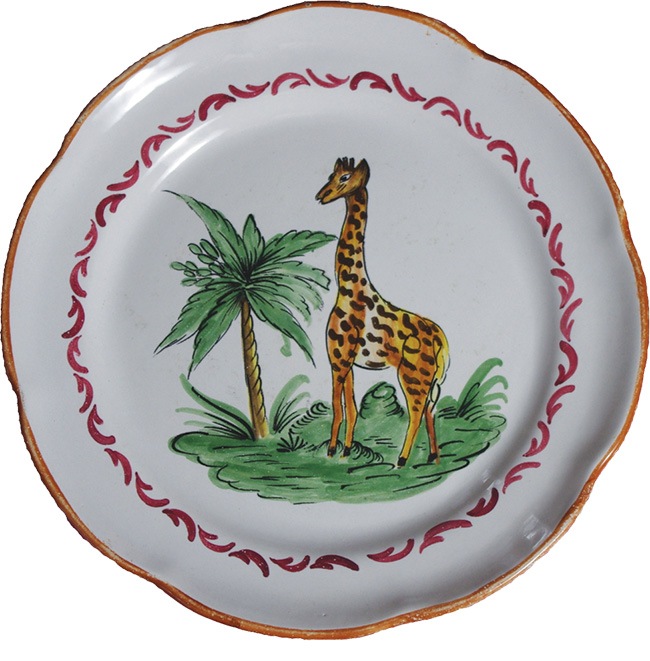France’s First Royal Giraffe
France’s first giraffe set hoof on French soil in 1826 and remained a hugely popular attraction in Paris until her death in 1845. Lara Dunn finds out more about the tall tale of Zarafa the giraffe.
On June 30, 1827 more than 100,000 people gathered in the streets of Paris to welcome the arrival of a new addition to the royal family of Charles X. This new member of the family was not a human infant, however, but a young giraffe, the first of her kind to ever be seen in France and the first to set hoof on European soil since the creature gifted to Lorenzo de’ Medici in Florence back in 1486. The young giraffe’s arrival in Paris was the culmination of nearly three years and more than 4,000 miles of travel from her birth in the deserts of Sudan, and to say she captured the public’s imagination would be an understatement.

The
Nubian Giraffe captures the ill-fated
English giraffe – Jacques-
Laurent Agasse documented
all three animals and their
entourages during their
journeys © Wikimedia Commons
Seized by a hunting party in Sudan at the behest of Mouker Bey, the Governor of Sudan, the giraffe was promised to Muhammed Ali, the Ottoman Viceroy of Egypt. In turn, it was then suggested to Muhammed Ali by his advisors that such an animal might be worthy of being a diplomatic gift for the recently crowned King Charles X of France. A second giraffe was also destined for George IV of Britain, and a third for Francis I of Austria.
The young giraffe was only a couple of months old when captured but already nearly six feet tall. Without her mother (who had been swiftly despatched during the hunt) she was vulnerable and fragile. Her captors knew from bitter experience that her transport could not be rushed if their precious prize was to survive, and so the epic journey began with her being carried by camel and accompanied by several cows to provide the unweaned youngster with milk. Two and a half years later after an arduous journey by camel, on foot and by felucca along the Nile, she finally arrived at the port of Alexandria, where she was loaded onto a ship bound for Marseille. Her now prodigious height required a hole to be cut in the deck above, for her head to poke through, which was protected from the elements by a tarpaulin. She travelled this way for 25 days.

Giraffe
Crossing, painted by Jacques
Raymond Brascassat in 1827 © Wikimedia Commons
Now widely known as Zarafa – a doubly apposite name playing on the Arabic for both giraffe and ‘beautiful’ or ‘lovely one’ – the exotic beast arrived at the Mediterranean port of Marseille on October 31, 1826, after a sea voyage of 32 days. Fears were expressed for the safety of the animal if she should be transported by ship around the Atlantic coast or on a boat up the Rhône to Paris, so it was decided that she should make her way to the capital on foot instead. Zarafa spent the winter resting in a custom-built stable in Marseille.
A leading natural history professor – Étienne Geoffroy Saint-Hilaire – was sent on royal command to accompany Zarafa on her final 550-mile walk to Paris. Saint-Hilaire, Zarafa and her handler were accompanied by mounted guards, three footmen – each with a leather leash to minimise any pulling of the animal – and some cows. Having previously travelled the world conducting zoological research, the ageing Saint-Hilaire was delighted to be a protector and companion to Zarafa, referring to her as being as “glorious as a peacock” and “as debonair as she is intelligent”. She was also almost 15cm taller than when she had arrived in Marseille the previous year.

A faïence plate
commemorating Zarafa © Wikimedia Commons
The stately journey from Marseille to Paris averaged just 2mph and took the party some 41 days. Zarafa herself was decked out in a custom-made, two-piece waxed raincoat to protect her from the inclement spring weather. At every step of the way, “the beautiful animal of the King” was a sensation, attracting huge crowds of spectators. In Aix-en-Provence, she made two separate promenades of the Cours Mirabeau, one in the morning and one in the evening, to allow for maximum appreciation, and when she arrived in Lyon on June 6, she attracted a crowd of nearly 30,000 people – almost a third of the city’s population at that time.
Charles X was desperately impatient to meet his four gangly-legged gift, angling to meet her on the road, but was advised to maintain royal decorum by waiting for her to actually arrive in Paris. During her leisurely procession up the length of France, the furthest the giraffe walked in any day was on that of her eventual arrival in Paris on June 30. She was led nine miles through the capital for her audience with the king at the Château de Saint-Cloud, then a further nine to the Jardin des Plantes, which was to be her new abode.

A. Thiébault’s painting, A Giraffe
from Sennaar, Africa, Presented
by the Pasha of Egypt to King
Charles X of France at Saint-
Cloud, July 9, 1827, is in the
Philadelphia Museum of Art © Wikimedia Commons
Centre of Attention
‘Her highness’ (pun entirely intended), as she was named by La Gazette was the belle of the jardin during her 17 years at the Jardin des Plantes, but her first year was particularly remarkable for its steady stream of excited visitors, including artists, writers and historians, all intent on capturing the giraffe’s moment in the spotlight.
That first summer alone she attracted more than 600,000 visitors. By the autumn, giraffe-mania was sweeping the city and indeed the whole country, with Zarafa’s likeness and signature spotted pattern appearing on everything from paintings to fashions, furniture, wallpaper and porcelain. Tall hairstyles ‘à la giraffe’ even became de rigueur for a time. Honoré de Balzac wrote about her and she numbered a young Gustave Flaubert amongst her excited visitors.
Zarafa had arrived at her final destination in relatively good health, unlike both of her contemporaries. The individual intended for George IV in Britain suffered badly from the effects of the journey. Although a key attraction at the new London Zoo in Regent’s Park, the English giraffe lived for only two years, largely unable to support her own weight due to her weakened physical condition. The Austrian giraffe survived for less than a year, at least in part due to an arduous crossing of the Alps to reach what was to be her home. Despite their short lives, these two leggy lovelies still had a huge impact on the fashions of the time in their adopted home countries, much as Zarafa did in France. It was still possible to find giraffe-themed pastries in Vienna as late as the First World War.
The Legend Lives On
Eventually, Zarafa’s popularity waned, although she lived out her 17 years at the Jardin des Plantes in a modicum of comfort, with a live-in handler for company. In 1845, ‘La Belle Africaine’ died in Paris. Her body was taxidermised and placed on display at the museum of the Jardin, before embarking on one final journey through France, to the Museum of Natural History in La Rochelle where she still resides today, as part of a collection of more than 10,000 treasures from Africa, America and Oceania.
Some remnants of her fame endure still, with a 2009 sculpture placed on Place Léon Blum in Marseille to celebrate her stay there, the 2012 French-Belgian animated movie Zarafa (trailer above), and a 1992 children’s book by Nancy Milton, The Giraffe That Walked to Paris. Could Zarafa have even been the inspiration behind Sophie the Giraffe, one of France’s best-loved children’s toys, created in 1961 by Vulli, a company based near Annecy? No matter – giraffe-mania lives on, even if the creature herself is long departed. The story of Zarafa the giraffe, it seems, is no tall tale.
From France Today magazine
Lead photo credit : La plus grande bête qu’on ait
jamais vue (the biggest beast
we’ve ever seen) is the caption
for this caricature of Charles X
as a giraffe, printed in 1830 © Wikimedia Commons
Your email address will not be published. Required fields are marked *
Source: francetoday.com
